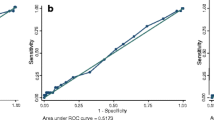Summary
A protein antigen — P-antigen — itcharacteristic of Branhamella catarrhalis has been described. Precipitating antibodies against this antigen occur in a majority of healthy human sera; serological evidence for a pathogenic role of B. catarrhalis is accumulating. The occurrence of complement-fixing antibodies has been demonstrated during broncho-pulmonary infection with B. catarrhalis and in maxillary sinusitis. Increases in antibody titres assessed by an enzyme-linked immunosorbent assay (ELISA) technique have been reported in children with acute otitis media. An ELISA, using purified P- antigen, for the evaluation of IgG, IgM and IgA antibodies against B. catarrhalis is being developed.
Similar content being viewed by others
References
Berger U. Die anspruchslosen Neisserien. Ergebenis Mikrobiologie 36: 97–167, 1963
Bøvre K. Family VIII. Neisseriaceae. In Holt and Krieg (Eds) Bergey’s manual of systematic bacteriology, pp. 288–310, Williams & Wilkins, Baltimore, 1984
Brorson J-E, Axelsson A, Holm SE. Studies on Branhamella catarrhalis (Neisseria catarrhalis) with special reference to maxillary sinusitis. Scandinavian Journal of Infectious Diseases 8: 151–155, 1976
Catlin BE. Transfer of the organism named Neisseria catarrhalis to Branhamella gen. nov. International Journal of Systematic Bacteriology 20: 155–159, 1970
Chapman Jr AJ, Musher DM, Jonsson S, Clarridge JE, Wallace Jr RJ. Development of bactericidal antibody during Branhamella catarrhalis infection. Journal of Infectious Diseases 151: 878–882, 1985
Doyle RJ, Nedjat-Haiem F, Keller KF, Frasch CE. Diagnostic value of interactions between members of the family Neisseriaceae and lectins. Journal of Clinical Microbiology 19: 383–387, 1984
Eliasson I. A protein antigen characteristic of Branhamella catarrhalis. Serological identification of the genus. Acta Pathologica et Microbiologica Scandinavica Sect. B88: 281–286, 1980
Fox RH, McClain DE. Evaluation of the taxonomic relationship of Micrococcus cryophilus, Branhamella catarrhalis, and Neisseriae by comparative polyacrylamide gel electrophoresis of soluble proteins. International Journal of Systematic Bacteriology 24: 172–176, 1974
Fox RH, McClain DE. Enzyme electrophoretograms in the analysis of taxon relatedness of Micrococcus cryophilus, Branhamella catarrhalis and atypical Neisserias. Journal of General Microbiology 86: 210–216, 1975
Janda WM, Morello JA, Bohnhoff M. Use of the API NeIdent System for identification of pathogenic Neisseria spp. and Branhamella catarrhalis. Journal of Clinical Microbiology 19: 338–341, 1984
Jantzen E. Analysis of cellular components in bacterial classification and diagnosis. In Odham, Larsson, Mårdh (Eds) Gas chromatography, mass spectrometry; applications in microbiology, Plenum Press, New York, 1984
Johnson KG, McDonald IJ, Perry MB. Studies on the cellular and free lipopolysaccharides from Branhamella catarrhalis. Canadian Journal of Microbiology 22: 460–467, 1976
Kamme C, Vang M, Ståhl S. Transfer of beta-lactamase production in Branhamella catarrhalis. Scandinavian Journal of Infectious Diseases 15: 225–226, 1983
Kamme C, Vang M, Ståhl S. Intrageneric and intergeneric transfer of Branhamella catarrhalis beta-lactamase production. Scandinavian Journal of Infectious Diseases 16: 153–155, 1984
Leinonen M, Luotonen J, Herva E, Valkonen K, Mäkelä PH. Preliminary serological evidence for a pathogenic role of Branhamella catarrhalis. Journal of Infectious Diseases 144: 570–574, 1981
Russell RRB, McDonald IJ. Comparison of the cell envelope proteins of Micrococcus cryophilus with those of Neisseria and Branhamella species. Canadian Journal of Microbiology 22: 309–312, 1976
Russell RRB, Johnsson KG, McDonald IJ. Immunological relationship of some non-pathogenic Neisseria. Canadian Journal of Microbiology 24: 189–191, 1978
Schalén L, Christensen P, Eliasson I, Fex S, Kamme C, Schalén C. Inefficacy of penicillin V in acute laryngitis in adults; evaluation from results of double-blind study. Annals of Otology, Rhinology & Laryngology 94: 14–17, 1985
Author information
Authors and Affiliations
Rights and permissions
About this article
Cite this article
Eliasson, I. Serological Identification of Branhamella catarrhalis . Drugs 31 (Suppl 3), 7–10 (1986). https://doi.org/10.2165/00003495-198600313-00004
Published:
Issue Date:
DOI: https://doi.org/10.2165/00003495-198600313-00004



